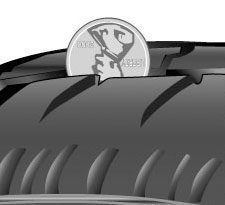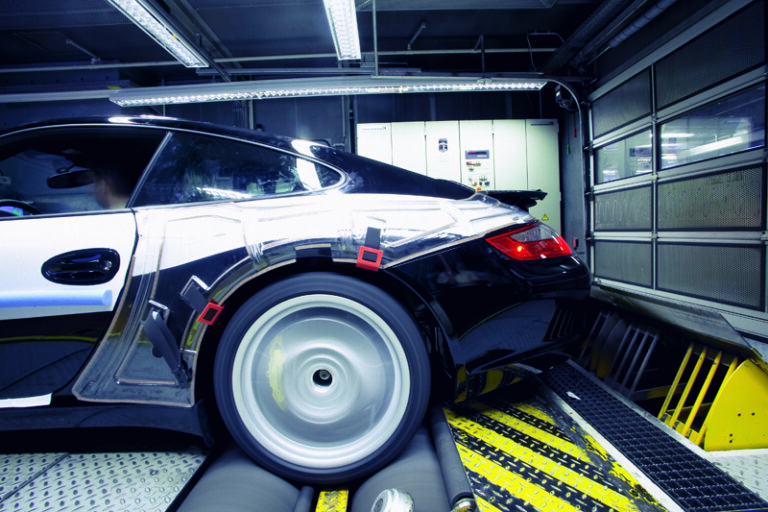Whoa, Baby!
By: Chris Rotvik–Oregon Region
In the eighties it seemed every other 911SC or Carrera 3.2 was equipped with a “whale tail.” These deck lid spoilers—inspired by the 911 Turbo, although usually a fiberglass copy of the ’74 RSR or IROC appendage—sprouted from the back of many a garden-variety 911 in a way vaguely reminiscent of a peacock’s feathers.
Of course there’s nothing wrong with that. In my view any good drive is about the sensations formed inside your noggin; if having that whale tail helped redline the drive satisfaction meter, then it was the right thing to do (although I do suspect a few were installed to improve trolling performance, not driving satisfaction!)
Are big brakes today’s equivalent of the whale tail? Aftermarket brake upgrades, from caliper paint to mega-buck big-brake kits, are rife. More and more cars now come from their maker decorated with behind-the-alloys jewelry (have you seen the metal sculptures BMW installs as brake discs on the new M6?). The appreciation of fine engineering that brought all of us to the Porsche marque keeps any of us from simply painting calipers red, but what about the more substantial brake upgrades?
Making sense of the potential benefits entails making sense of what brakes do. (Yes, yes, we all know they stop the car, but how do they go about it?). Oversimplified, brakes convert energy in one form (forward momentum) to another form (heat) and store it until that heat can be dissipated. The energy conversion comes about via the back-and-forth exchange of molecules between pad and rotor. And each rotor is a huge heat sink that eventually gives up its stored energy to the atmosphere (and to a lesser degree, undesirably, to adjacent parts such as wheel bearings).
Perhaps more than any other auto manufacturer, Porsche is renowned for the braking capacity of the vehicles it produces. Porsche standards demand a number of repeated high-speed stops while showing no degradation in braking performance. With this in mind, when might a brake upgrade be appropriate? If you paid attention during physics 101 (I didn’t) you’ll recall that the momentum being converted is the product of mass times velocity (you gotta love Wikipedia). Simply put, unless you’re adding significant top speed capability or weight to your Porsche, it’s unlikely that you’ll need more over-the-road braking performance than Porsche designed in.
It’s at this point that the track and autocross junkies are saying “but, but, but!”
Harking back to the two things brakes do—converting energy and then dissipating it— deficiencies in braking generally fall into two categories: one, insufficient retardation and two, fading with use. Simplistically, how well your brakes retard speed is a function of the pad/rotor contact area and the caliper’s clamping force, pad and rotor composition and operating temperature, and the tire’s grip. This latter factor—tire grip—is important to keep in mind: unless you are running slicks or track-biased street tires like Michelin’s Pilot Sport Cup, in all likelihood your tires, not your brakes, are the weakest link in the ability to shed speed.
Let’s move on to fade for a moment. Repetitively bleeding off big speed will build up a huge stockpile of heat. The brake rotor acts as a reservoir for the heat until it can be dissipated into the air. Fade occurs when heat is produced faster than it can be dissipated and the heat-carrying capacity of the reservoir—the rotor—is overwhelmed. Adjacent components, notably the pads and brake fluid, overheat to a point where their ability to do their job is significantly compromised. Fade is unlikely to be an issue in autocross; there just isn’t enough time in a run to overwhelm the heat capacity of the rotors.
Up to this point we’ve ignored the driver. Braking technique is a fine art that takes years to perfect. Poor technique on the track can induce fade; good technique can extract an amazing amount of performance from Porsche’s stock setup. Unless you’re a track meister, consider focusing on driver skills before making major mechanical upgrades.
Approach brake upgrades thoughtfully. Begin by getting clear about your goal: Are you trying to reduce fade, increase the ultimate bite of your brakes, or fill the space behind your new bling-bling 20s? Seek out advice: The PCA’s Tech Q&A (http://www.pca.org/tech/tech_qa.asp) is a great place to start, as are our local DE instructors. Make changes one at a time, evaluating the outcome before planning the next step. Start with the basics: Brake fluid and pads designed to retain their effectiveness at higher operating temperatures, venting to increase heat dissipation, and good technique will go a long way to reduce fade for the track-day junkie running a street-legal vehicle. Finally, be aware of the compromises: A big brake kit comes at the expense of greater unsprung weight (impacting handling), potentially poorer on-road performance (track pads need some degree of heat to bite effectively) and all-weather suitability (is the system designed with seals and splash guards appropriate for use in the wet?).
We all love to modify our cars. It’s part of how we bond with them, make them part of us, make them reflect our ideals. For the track junkie, brake upgrades are valuable and inevitable. For the rest of us, time spent on track learning proper technique with a driving instructor may pay off more handsomely.




